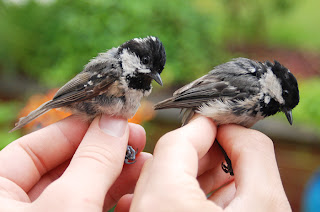On Sunday afternoon, we booked our first 'real' succes with the trap in the garden. After a Robin, four Feral Pigeons and 2 Grey Squirrels we got a Wood Pigeon in the trap. It was the 4th Wood Pigeon to be ringed in Menzie's garden in two weeks time, not a bad score!
Wood Pigeon (Columba palumbus); I'll leave the in-depth analysis of the age to Menzie of course!
Sunday evening we headed to Woolston where we camped overnight. A ringing session was held the next morning. The ringing was nice; we ringed 5 Bullfinches, 2 Willow Tits, some Reed Buntings, Chiffchaffs, Willow Warblers, Blackcaps and Wrens. There was a good amount of juvenile birds; good to know that some birds here still dealt fine with the horrendous weather the UK has had the past month.
A purple pink sunset at Woolston.
Song Thrush (Turdus philomelos ssp. clarkei); 2cy male of the British subspecies; the continental Song Thrushes are greyer on the upperparts (note the brown-cap of this bird) and have less buff on underparts than the British ones
Willow Tit (Poecile montanus ssp. kleinschmidti); juvenile, the continental Willow Tits are supposed to be larger and greyer and paler than the British Willow Tits
Robin (Erithacus rubecula ssp. melophilus); 1cy, never seen a (juv) Robin with such grey pinkish legs
Winter Wren (Troglodytes troglodytes ssp. indigenus); adult, the British birds should be darker and browner than the nominate. Though, I don't see a colour difference with a Continental Wren in the bird pictured above
Bullfinch (Pyrrhula pyrrhula ssp. pileata); 2cy male, the British birds are less brightly coloured and smaller than the nominate.
Wing of the Bullfinch: note the two retained old greater coverts, carpal covert and alula 1.
The information concerning the subspecies all comes from the article: Bird forms in Britain by Steve Gantlett from the paper Birding World, Volume 11, Number 6, 1998.




















































